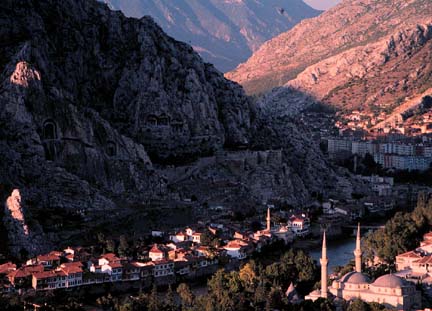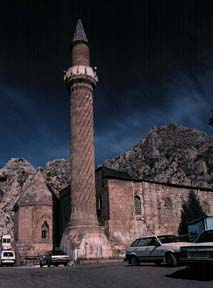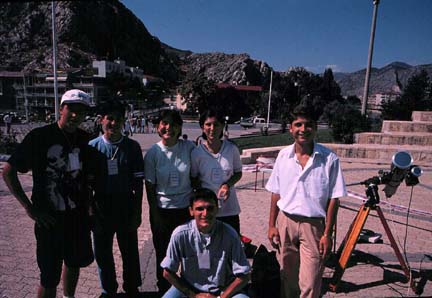
Amasya Turkey hugs the Yellow River which flows to the Black Sea. Tombs of the Pontic kings are carved into the limestone cliffs behind the town.

A 700 year old minaret next to our eclipse site, ringed by
loudspeakers and cell phone antennas.
Explainers of Amasya
One day before the eclipse, at the exact time of first contact, I went to visit our eclipse site in the town square of Amasya Turkey. It was a great site. There was an open plaza with small but sufficient shade trees next to one edge. I stood in the center of the plaza and saw that there would be a clear view of the entire eclipse. Looking around I could see that I definitely was not in Kansas anymore. 500 meter high (1500 foot) limestone cliffs rose up around the town. On top of one stood a "castle" built by kings over two thousand years ago and later used by the Roman Legions of Caesar, and later still by the Ottoman empire. Right next to the square there was a mosque built in 1300 AD. In a clear portrayal of modern Turkey the minaret of this mosque was ringed by loudspeakers which broadcast the greatly amplified call to prayer five times each day.


A 700 year old minaret next to our eclipse site, ringed by
loudspeakers and cell phone antennas.
As I was looking around at the thousands of years of human history, I received a surprise, 6 high school students arrived. They all wore tags proclaiming them to be official "Guides." They all spoke some English. I don't know why the tourist minister sent them to the Exploratorium eclipse site but, I did know what I wanted to do, I wanted to spend the next couple of hours giving them an Explainer training, a special pre-eclipse "light walk." Then, during the eclipse, they could show the partial phases to the townspeople.

I started by having them take me to the stationery store to buy some sheets of thin white cardboard. I then cut out a piece about the size of a 5 by 7 card, then cut a triangular hole in the center of the card big enough to stick a ballpoint pen through. I placed the rest of the white cardboard on the ground as a screen then held the card near the screen producing a triangular patch of light in the middle of a shadow. As I moved the card away the triangle of light metamorphosed into a disk of light. An image of the sun. I held a pen a meter above the hole and moved it down, the shadow of the pen seen on the ground moved down - except for the shadow seen in the disk image of the sun, that moved up. The Amasya Explainers were good observers, they saw this themselves and looked very puzzled. I left them to discuss it and figure it out. They immediately took to the the Exploratorium style of exploratory learning. I wished I had two lightbulbs to help them understand the pinhole image they were observing.
In the square with me was a kindred spirit - scientist/educator Cheri Morrow. Together we mounted her binoculars on my tripod and projected an image of the sun onto the cardboard screen. Sunspots were easily visible. Amasya Explainer John asked if the sun rotated and Cheri explained that it did rotate but not as a one piece solid like the earth, that the sun rotated faster at the equator than at the poles. John said that his teacher said that the sun did not rotate. We immediately had the students mark the positions of the sunspots on the image of the sun projected on the screen planning to have them check the positions tomorrow or the next day. That way they could see if the sun rotated for themselves.
We also showed them another lightwalk favorite, how to hold up their hands with the fingers crossed to make an array of pinholes. The pinhole array made many solar images on the screen. Tomorrow, we said, the images of the partially eclipsed sun would be interesting. I thought they would be especially interesting in Turkey where the crescent of the sun would mimic the crescent moon on the flag.
Before I finished with the lesson, we all went back to the stationery store and purchased enough cardboard to make each explainer a personal set of triangular pinhole sun image makers and screens for tomorrow's eclipse. After a mere two hours, these six students were adopted as Explainers of the Exploratorium's Amasya base camp.
Later that afternoon, Berkeley educator Jeff came by and heard what we were up to. He took the students off to a local Internet cafe to look at Galileo's drawings of sunspots on the NASA Sun-Earth Connection website. Galileo's drawings clearly showed that sunspots moved from day to day.
At night I thought about the parallels of how Galileo faced the authority of the church and how these students and many others around the world today still studied in authoritarian classrooms. But I couldn't ponder this for long, there was work to do to get things ready for tomorrow.
Visit the Exploratorium web pages for more information on eclipses:
First Contact, when the disk of the moon just touches the sun. Back.
The explainers at the Exploratorium guide visitors through the exhibits. Back.
A light walk is a special investigation of light developed by artist Bob Miller. Back.
Links to other eclipse stories:
Eclipse Disaster, the story of a partial solar eclipse in the Exploratorium's front yard.
Going Up? Get Fit! Adapting to high altitude for the eclipse in Chile.
|
Scientific Explorations with Paul Doherty |
|
27 July 99 |